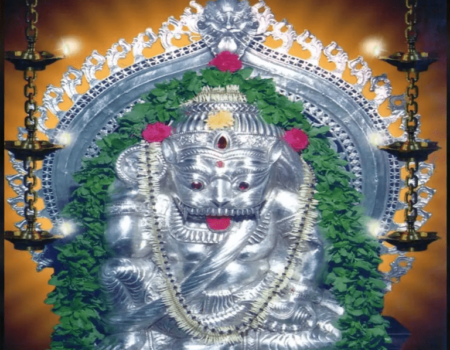Sri Guru Narasimha Temple

Pushkara Khanda chapter of Padma purana has details of this temple. Suta Puranika narrated this mahatme on the request of Muni Pungavas.
The land mass given by Samudra Raja on the request of Parashurama ranging from the current Gokarna on the North to Kanyakumari on the south is called Parashurama Kshetra.
This place has many important Thirta Kshetras and Thirta Sarovaras. Narada Muni visited the place between Seetha river and Kumbha Kashi kshetra where many Koota Muni Pungavas where meditating, after taking holy dip in different theerta sarovaras and meditating at thirta kshetras.
During this time a unexpected event happened at this place. Earth shook and there was a thunderous sound. All animals were scared and birds circled the sky. There was heavy winds and the freightned Munis came to Narada and requested for protection. Suddenly they heard a Divya Vani that preached about Narasimha Vichara.
The Divya Vani informed that an idol of Lord Narasimha, holding Shanka and Chakra in both hands and seated in Yogananda Posture that is worshiped by Brahma and Rudra is sitated between Shanka and Chakra thirta in middle of a Ashwatta (people) tree. This will be installed by Narada Muni. Narada agreed that he had realized the same during his meditation.
They searched and found the statue of Lord Narasimha and prayed to him. Narada then installed the statue of Lord Narasimha in between Shanka and Chakra Theertha. On Narada’s prayer Lord Narasimha appeared and as per his request agreed to be there in the location permanently.
This place in the middle of Koota Kshetra, where Lord Narasimha resides in Saligrama idol is called Saligrama. Devotees will acheive all their desires by worshipping this Saligrama idol. Taking holy dip in Chakra Theertha rids one of all diseases and fear of enemy. Holy dip in Shanka Theerta clenses one from all the sins. One who takes holy dip in both the theerthas and worships Narasimha will attain prosperity.
According to Skanda Purana Sahyadri Kanda, learned Brahmin families under the leadership of Bhattacharya, came to present day Saligrama from Ahichatra on the banks of Godavari river, on the request of King Lokaditya. King Lokaditya wanted to reinstate learned Brahmins in his kindgom for the prosperity of the kingdom. Maha Yagna’s like “Atiratra” were performed by these Brahmins on request of King Lokadithya. Before starting these yagnas, “to avoid obstacles” these learned, prayed to Lord Ganapathi and obtained blessings.
Bhattacharya was delighted to see elephants and lions living together, a situation which he had already experienced during his meditation and named this place “Nirvairya Sthala” meaning “Enemy less abode”. This is signified by the symbolic representation of elephant in the form of Lord Ganapathi and Lion in the form of Lord Narasimha, even till this date in the Saligrama temple. The idol is facing west and has chakra in right hand and conch shell in the left hand.
King Lokaditya allocated 14 villages to Brahmins who accompanied Bhattacharya and requested them to stay there and perform yagas and yajnas. While returning back to Ahichatra, Bhattacharya instructed his disciples staying back, to worship Lord Narasimha as both Guru and Lord.
From those days we Koota Brahmins worship Lord Narasimha as both Guru and Lord.
